Supply Chain Analysis: Recommendations for Service Level Policy Review
VerifiedAdded on 2023/04/03
|5
|734
|192
Report
AI Summary
This report provides recommendations for a company's policy of offering all its customers the same service level in its supply chain. It argues that differentiating service delivery based on order quantity would be more beneficial. The recommendations focus on logistics, packaging, and clearance processes. The report suggests implementing tiered services where customers who place larger orders receive preferential treatment, such as coverage of logistics costs and expedited clearance. By differentiating services, the company can reduce costs, save time, motivate customers to buy in bulk, and improve overall efficiency. The report includes a basic calculation of profit contribution percentage to demonstrate the potential financial impact of improved supply chain management.
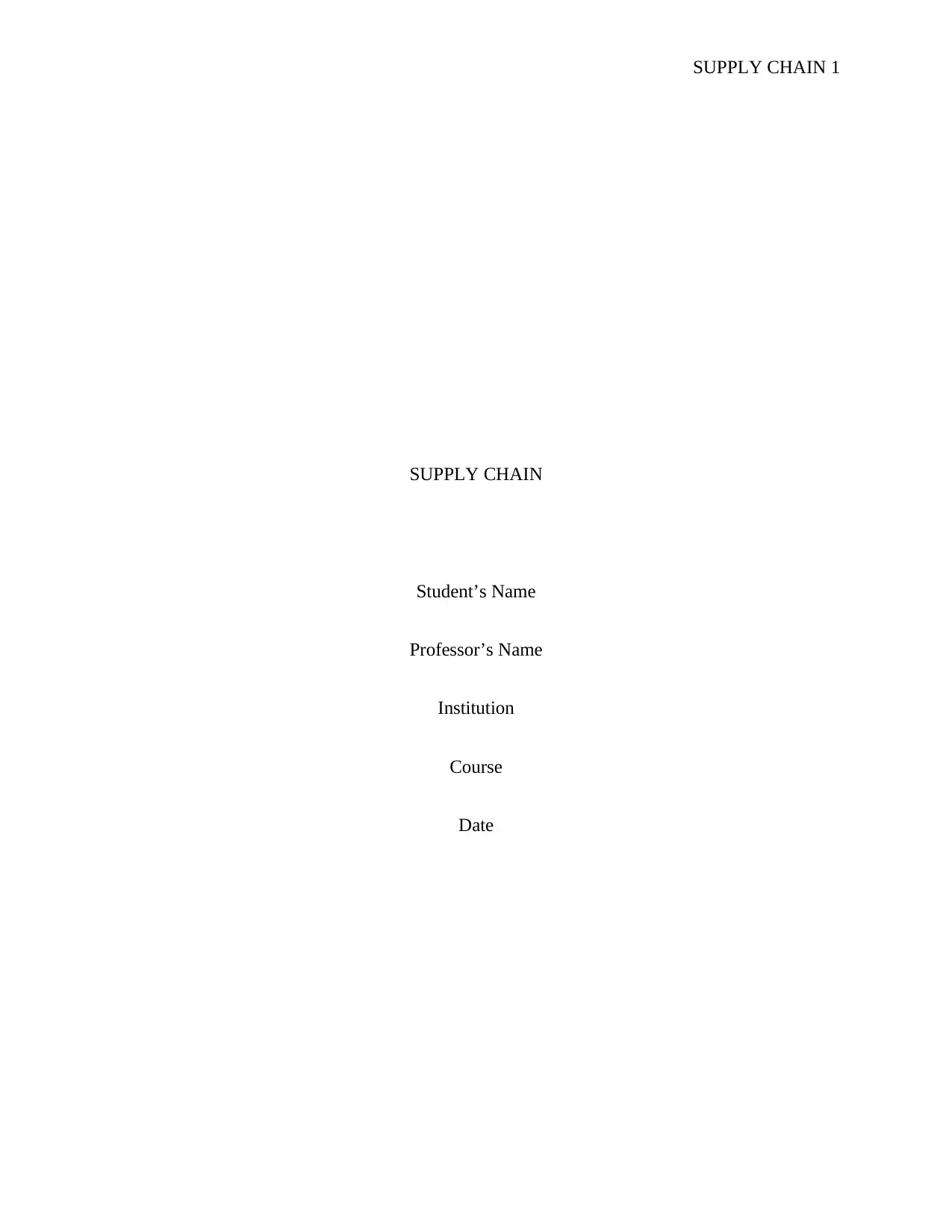
SUPPLY CHAIN 1
SUPPLY CHAIN
Student’s Name
Professor’s Name
Institution
Course
Date
SUPPLY CHAIN
Student’s Name
Professor’s Name
Institution
Course
Date
Paraphrase This Document
Need a fresh take? Get an instant paraphrase of this document with our AI Paraphraser
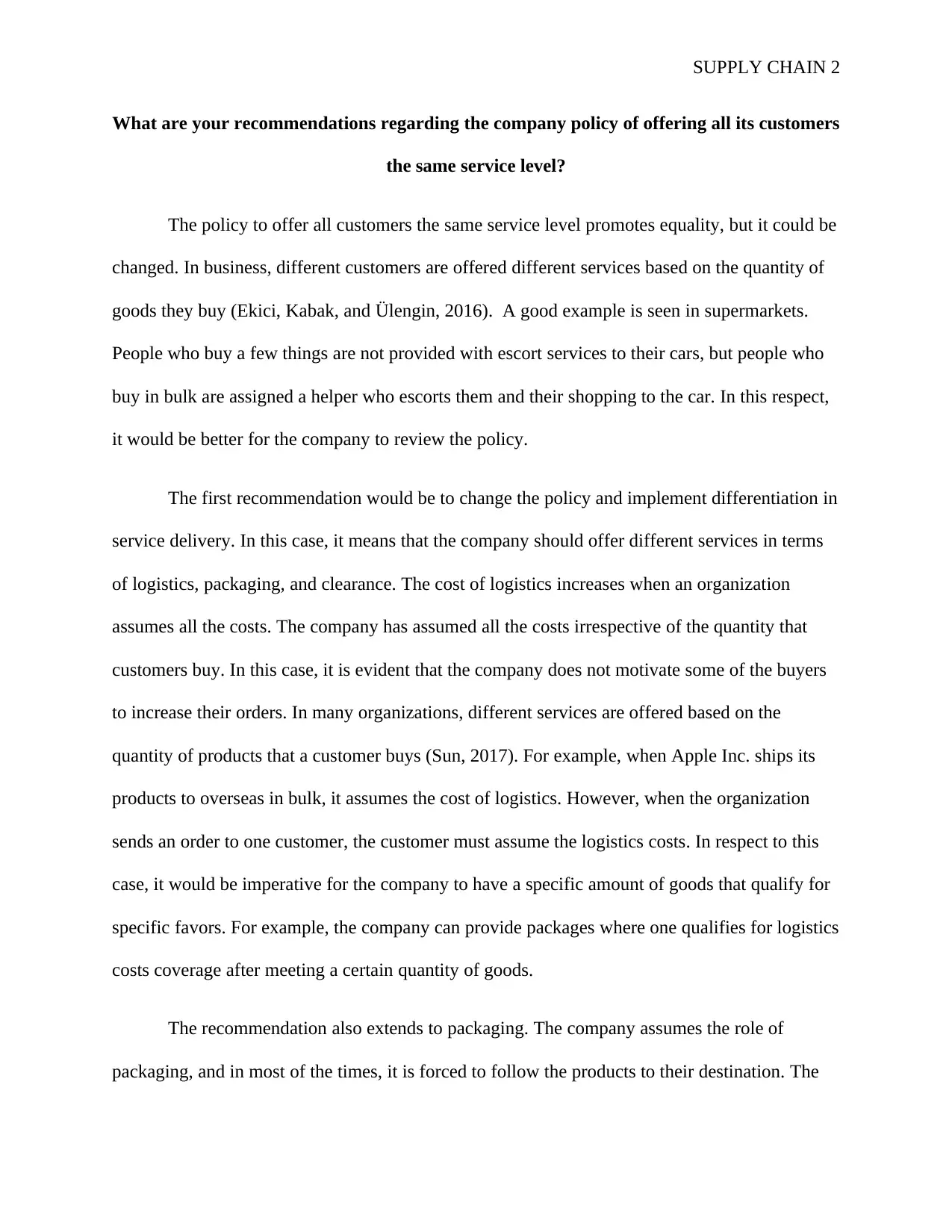
SUPPLY CHAIN 2
What are your recommendations regarding the company policy of offering all its customers
the same service level?
The policy to offer all customers the same service level promotes equality, but it could be
changed. In business, different customers are offered different services based on the quantity of
goods they buy (Ekici, Kabak, and Ülengin, 2016). A good example is seen in supermarkets.
People who buy a few things are not provided with escort services to their cars, but people who
buy in bulk are assigned a helper who escorts them and their shopping to the car. In this respect,
it would be better for the company to review the policy.
The first recommendation would be to change the policy and implement differentiation in
service delivery. In this case, it means that the company should offer different services in terms
of logistics, packaging, and clearance. The cost of logistics increases when an organization
assumes all the costs. The company has assumed all the costs irrespective of the quantity that
customers buy. In this case, it is evident that the company does not motivate some of the buyers
to increase their orders. In many organizations, different services are offered based on the
quantity of products that a customer buys (Sun, 2017). For example, when Apple Inc. ships its
products to overseas in bulk, it assumes the cost of logistics. However, when the organization
sends an order to one customer, the customer must assume the logistics costs. In respect to this
case, it would be imperative for the company to have a specific amount of goods that qualify for
specific favors. For example, the company can provide packages where one qualifies for logistics
costs coverage after meeting a certain quantity of goods.
The recommendation also extends to packaging. The company assumes the role of
packaging, and in most of the times, it is forced to follow the products to their destination. The
What are your recommendations regarding the company policy of offering all its customers
the same service level?
The policy to offer all customers the same service level promotes equality, but it could be
changed. In business, different customers are offered different services based on the quantity of
goods they buy (Ekici, Kabak, and Ülengin, 2016). A good example is seen in supermarkets.
People who buy a few things are not provided with escort services to their cars, but people who
buy in bulk are assigned a helper who escorts them and their shopping to the car. In this respect,
it would be better for the company to review the policy.
The first recommendation would be to change the policy and implement differentiation in
service delivery. In this case, it means that the company should offer different services in terms
of logistics, packaging, and clearance. The cost of logistics increases when an organization
assumes all the costs. The company has assumed all the costs irrespective of the quantity that
customers buy. In this case, it is evident that the company does not motivate some of the buyers
to increase their orders. In many organizations, different services are offered based on the
quantity of products that a customer buys (Sun, 2017). For example, when Apple Inc. ships its
products to overseas in bulk, it assumes the cost of logistics. However, when the organization
sends an order to one customer, the customer must assume the logistics costs. In respect to this
case, it would be imperative for the company to have a specific amount of goods that qualify for
specific favors. For example, the company can provide packages where one qualifies for logistics
costs coverage after meeting a certain quantity of goods.
The recommendation also extends to packaging. The company assumes the role of
packaging, and in most of the times, it is forced to follow the products to their destination. The
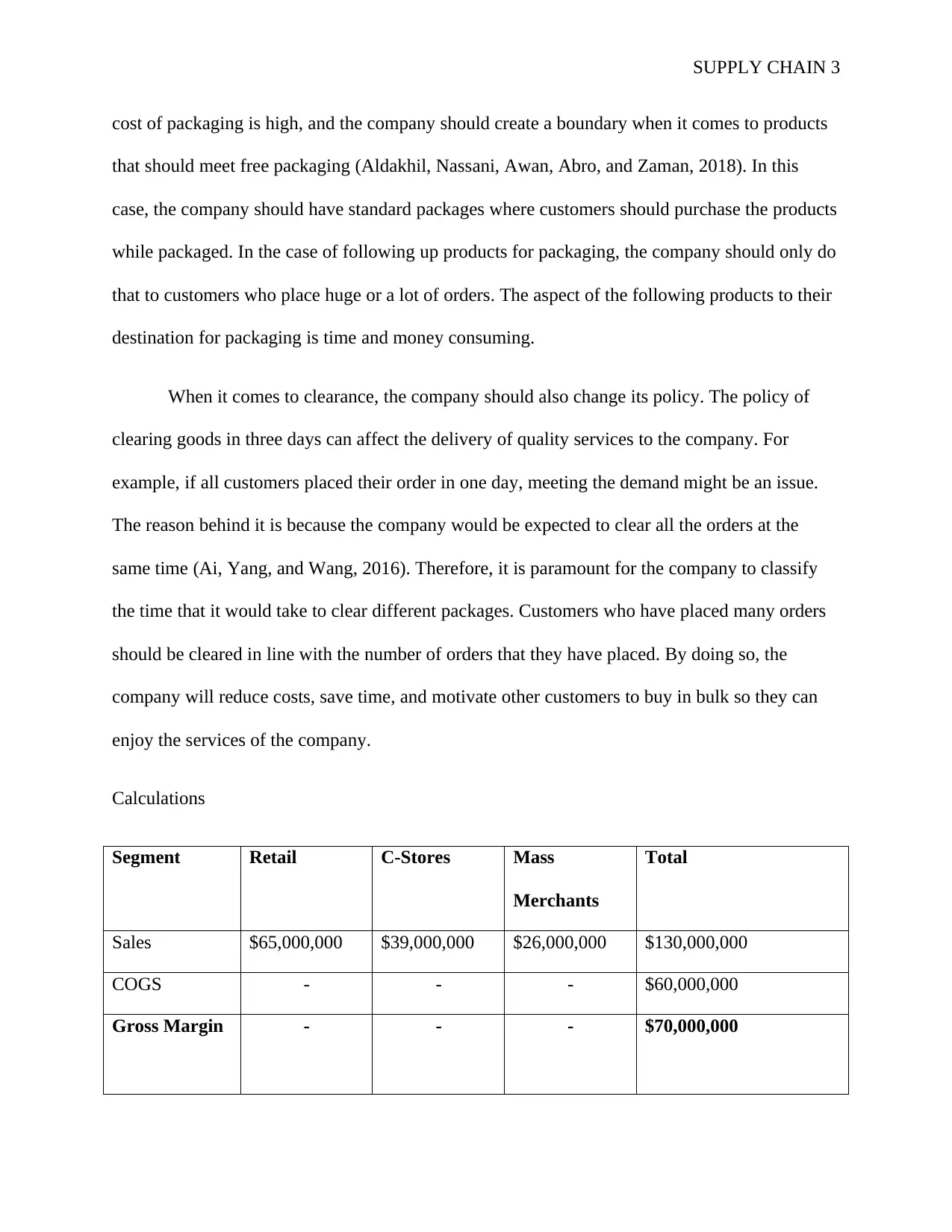
SUPPLY CHAIN 3
cost of packaging is high, and the company should create a boundary when it comes to products
that should meet free packaging (Aldakhil, Nassani, Awan, Abro, and Zaman, 2018). In this
case, the company should have standard packages where customers should purchase the products
while packaged. In the case of following up products for packaging, the company should only do
that to customers who place huge or a lot of orders. The aspect of the following products to their
destination for packaging is time and money consuming.
When it comes to clearance, the company should also change its policy. The policy of
clearing goods in three days can affect the delivery of quality services to the company. For
example, if all customers placed their order in one day, meeting the demand might be an issue.
The reason behind it is because the company would be expected to clear all the orders at the
same time (Ai, Yang, and Wang, 2016). Therefore, it is paramount for the company to classify
the time that it would take to clear different packages. Customers who have placed many orders
should be cleared in line with the number of orders that they have placed. By doing so, the
company will reduce costs, save time, and motivate other customers to buy in bulk so they can
enjoy the services of the company.
Calculations
Segment Retail C-Stores Mass
Merchants
Total
Sales $65,000,000 $39,000,000 $26,000,000 $130,000,000
COGS - - - $60,000,000
Gross Margin - - - $70,000,000
cost of packaging is high, and the company should create a boundary when it comes to products
that should meet free packaging (Aldakhil, Nassani, Awan, Abro, and Zaman, 2018). In this
case, the company should have standard packages where customers should purchase the products
while packaged. In the case of following up products for packaging, the company should only do
that to customers who place huge or a lot of orders. The aspect of the following products to their
destination for packaging is time and money consuming.
When it comes to clearance, the company should also change its policy. The policy of
clearing goods in three days can affect the delivery of quality services to the company. For
example, if all customers placed their order in one day, meeting the demand might be an issue.
The reason behind it is because the company would be expected to clear all the orders at the
same time (Ai, Yang, and Wang, 2016). Therefore, it is paramount for the company to classify
the time that it would take to clear different packages. Customers who have placed many orders
should be cleared in line with the number of orders that they have placed. By doing so, the
company will reduce costs, save time, and motivate other customers to buy in bulk so they can
enjoy the services of the company.
Calculations
Segment Retail C-Stores Mass
Merchants
Total
Sales $65,000,000 $39,000,000 $26,000,000 $130,000,000
COGS - - - $60,000,000
Gross Margin - - - $70,000,000
⊘ This is a preview!⊘
Do you want full access?
Subscribe today to unlock all pages.

Trusted by 1+ million students worldwide
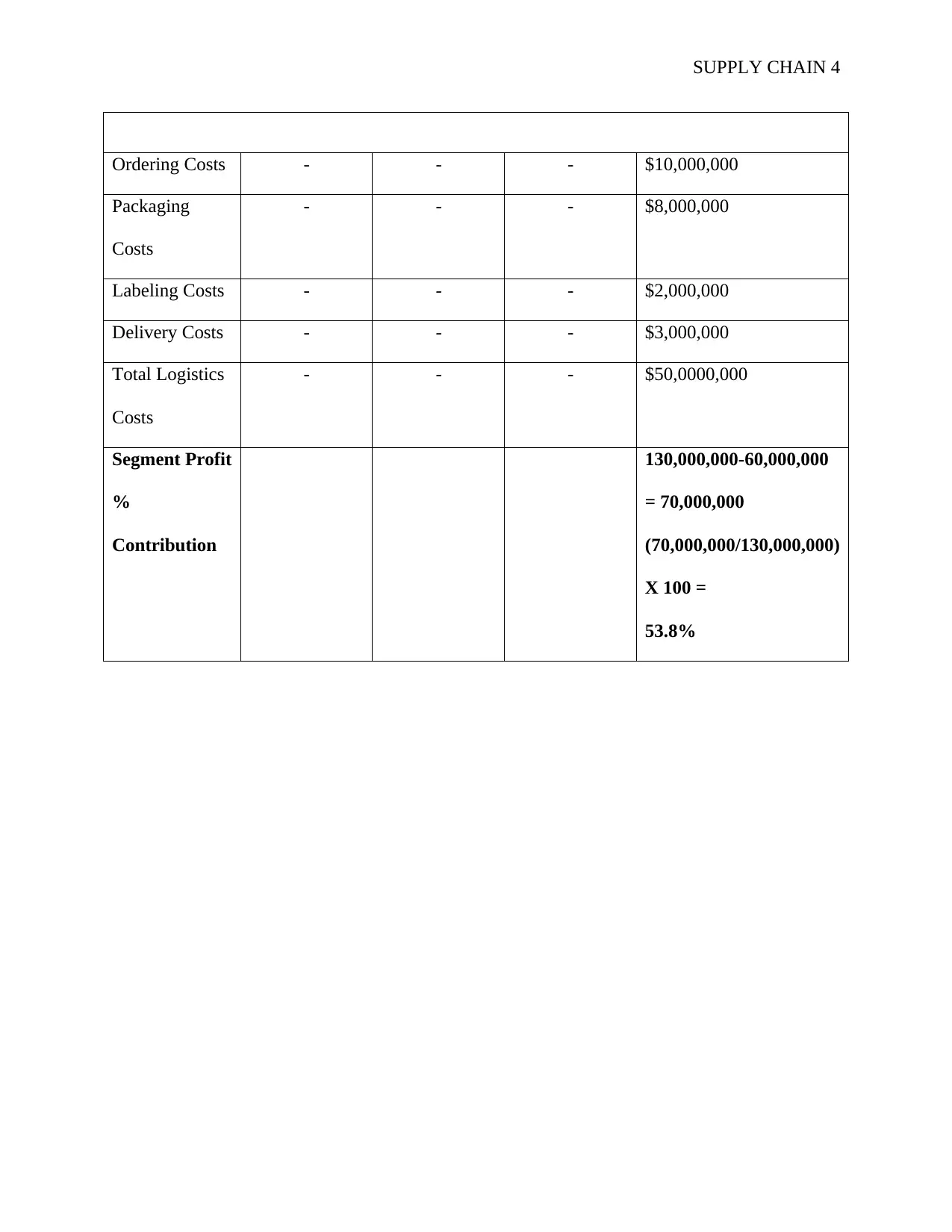
SUPPLY CHAIN 4
Ordering Costs - - - $10,000,000
Packaging
Costs
- - - $8,000,000
Labeling Costs - - - $2,000,000
Delivery Costs - - - $3,000,000
Total Logistics
Costs
- - - $50,0000,000
Segment Profit
%
Contribution
130,000,000-60,000,000
= 70,000,000
(70,000,000/130,000,000)
X 100 =
53.8%
Ordering Costs - - - $10,000,000
Packaging
Costs
- - - $8,000,000
Labeling Costs - - - $2,000,000
Delivery Costs - - - $3,000,000
Total Logistics
Costs
- - - $50,0000,000
Segment Profit
%
Contribution
130,000,000-60,000,000
= 70,000,000
(70,000,000/130,000,000)
X 100 =
53.8%
Paraphrase This Document
Need a fresh take? Get an instant paraphrase of this document with our AI Paraphraser
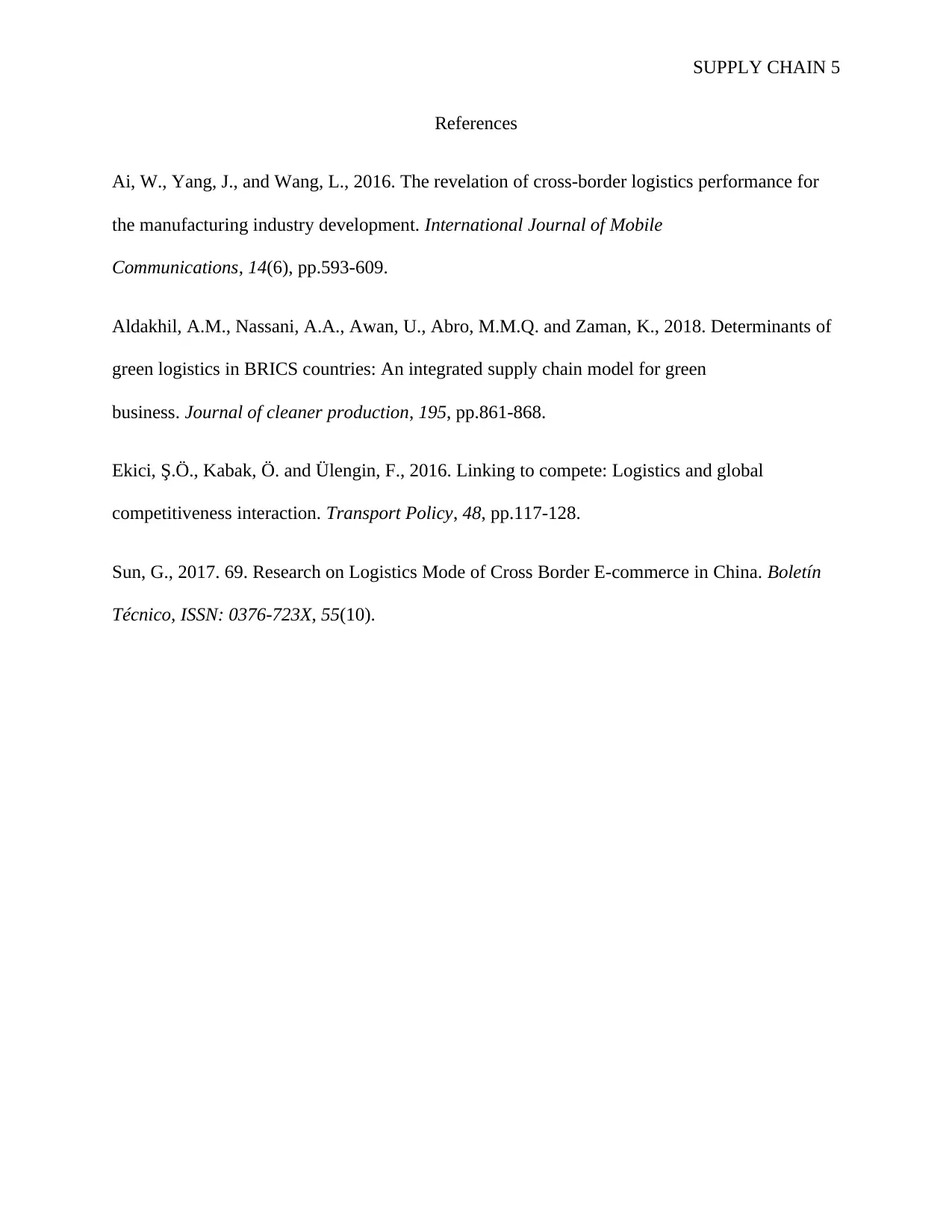
SUPPLY CHAIN 5
References
Ai, W., Yang, J., and Wang, L., 2016. The revelation of cross-border logistics performance for
the manufacturing industry development. International Journal of Mobile
Communications, 14(6), pp.593-609.
Aldakhil, A.M., Nassani, A.A., Awan, U., Abro, M.M.Q. and Zaman, K., 2018. Determinants of
green logistics in BRICS countries: An integrated supply chain model for green
business. Journal of cleaner production, 195, pp.861-868.
Ekici, Ş.Ö., Kabak, Ö. and Ülengin, F., 2016. Linking to compete: Logistics and global
competitiveness interaction. Transport Policy, 48, pp.117-128.
Sun, G., 2017. 69. Research on Logistics Mode of Cross Border E-commerce in China. Boletín
Técnico, ISSN: 0376-723X, 55(10).
References
Ai, W., Yang, J., and Wang, L., 2016. The revelation of cross-border logistics performance for
the manufacturing industry development. International Journal of Mobile
Communications, 14(6), pp.593-609.
Aldakhil, A.M., Nassani, A.A., Awan, U., Abro, M.M.Q. and Zaman, K., 2018. Determinants of
green logistics in BRICS countries: An integrated supply chain model for green
business. Journal of cleaner production, 195, pp.861-868.
Ekici, Ş.Ö., Kabak, Ö. and Ülengin, F., 2016. Linking to compete: Logistics and global
competitiveness interaction. Transport Policy, 48, pp.117-128.
Sun, G., 2017. 69. Research on Logistics Mode of Cross Border E-commerce in China. Boletín
Técnico, ISSN: 0376-723X, 55(10).
1 out of 5
Related Documents
Your All-in-One AI-Powered Toolkit for Academic Success.
+13062052269
info@desklib.com
Available 24*7 on WhatsApp / Email
![[object Object]](/_next/static/media/star-bottom.7253800d.svg)
Unlock your academic potential
Copyright © 2020–2025 A2Z Services. All Rights Reserved. Developed and managed by ZUCOL.




